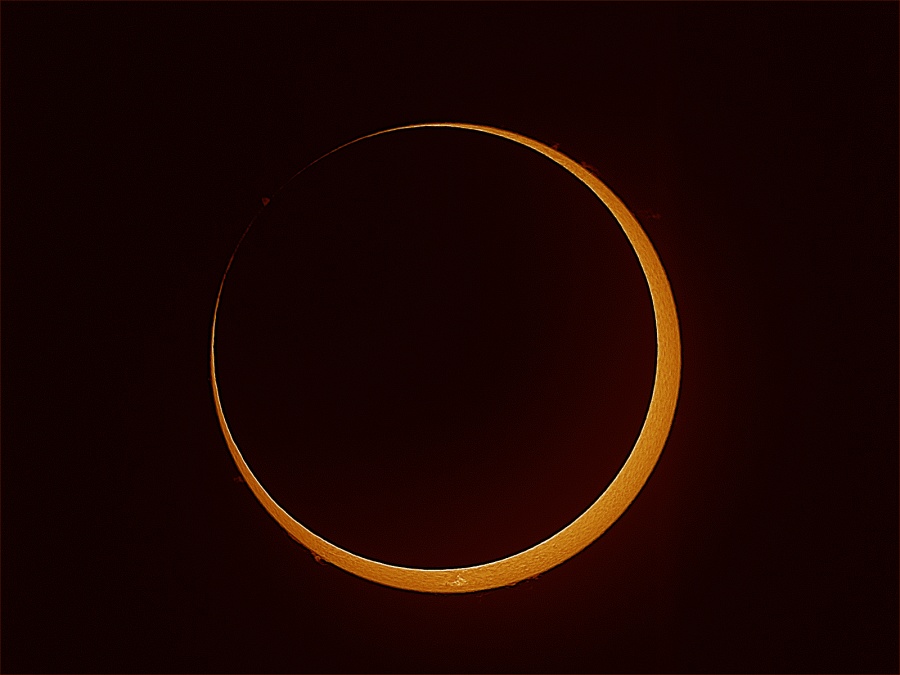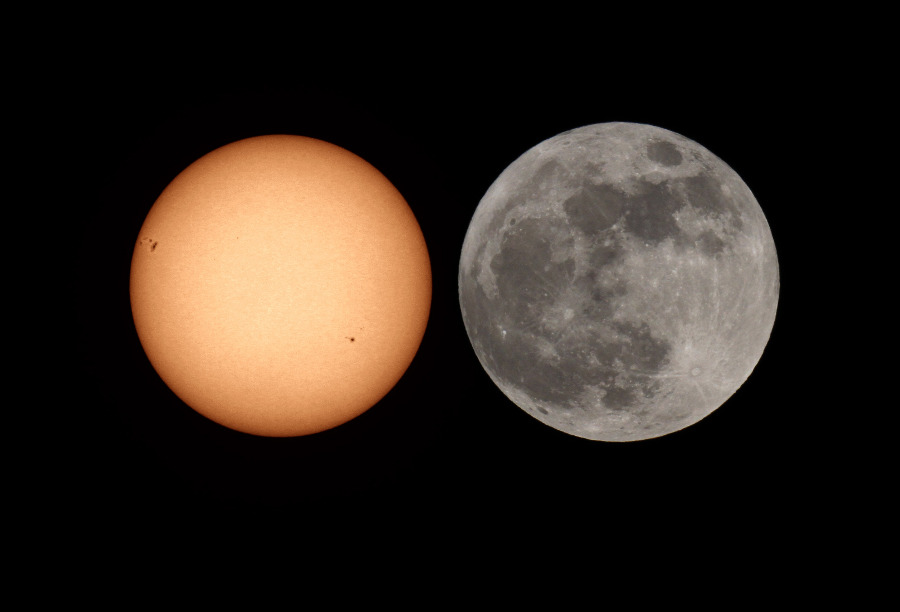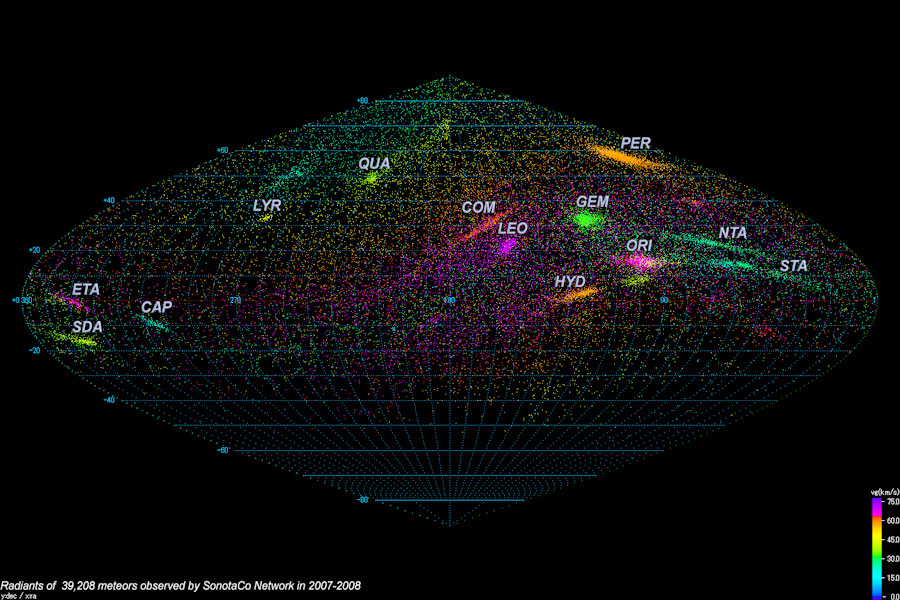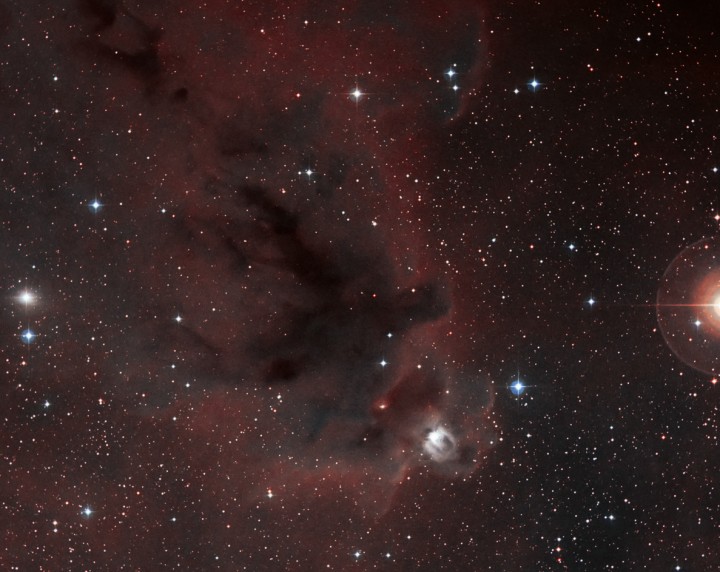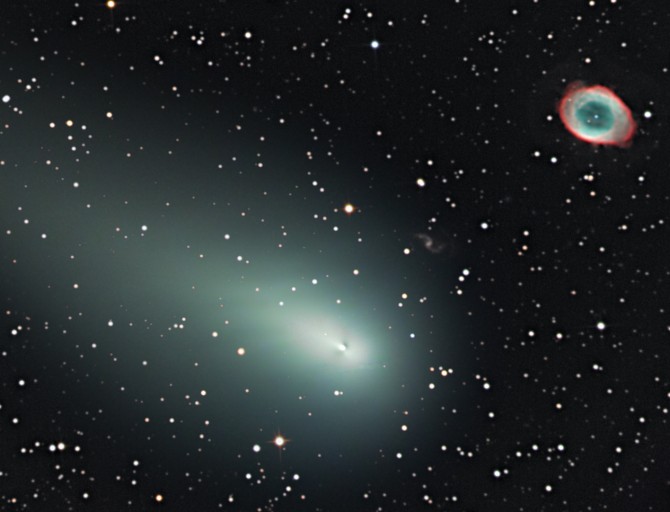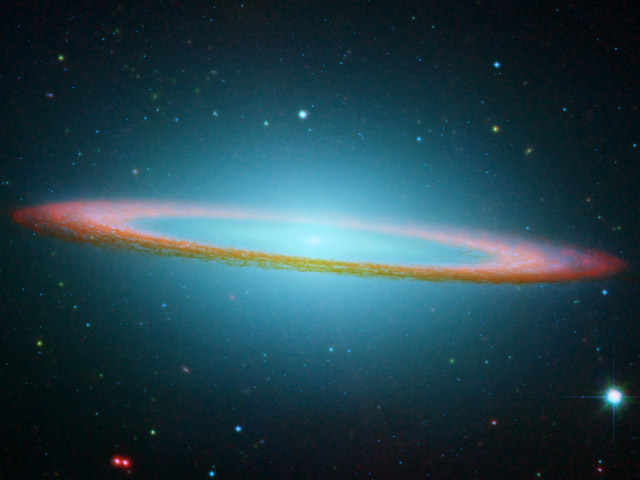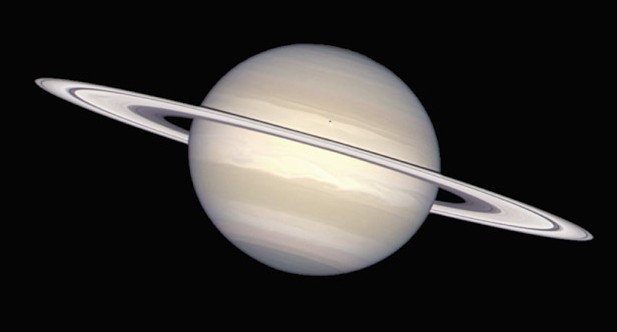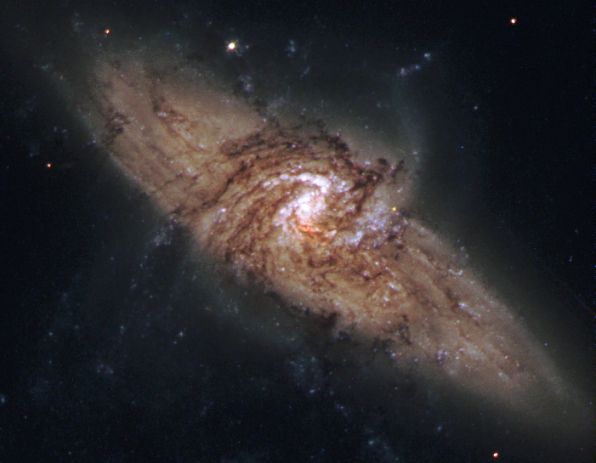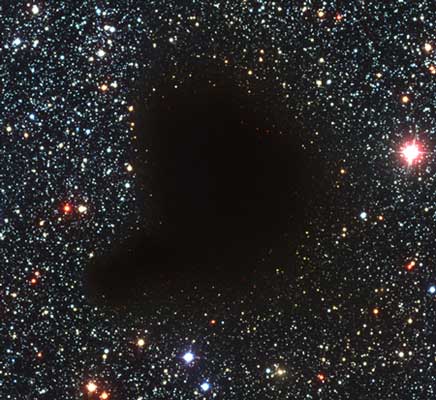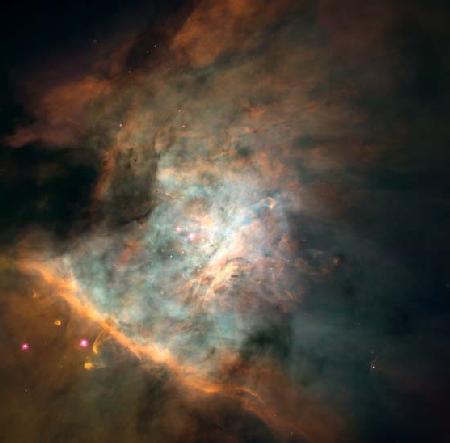| << Previous | Index | Next >> |
2015 What if you could stand at the top of a volcano and peer out across the universe? It the timing is right, you might see an amazing panorama like the one featured here. In this case, the volcano is the Hawaii's Mauna Kea, and the time was a clear night last summer In the foreground of this south-facing panorama lies a rugged landscape dotted with rocks and hardy plants. Slightly above and further out, a white blanket of clouds spreads horizontally to the horizon, seemingly dividing heaven and Earth. City lights illuminate the clouds and sky on the far left, while orange lava in the volcanic caldera of Kilauea lights up the clouds just left of center. The summit of an even more distant Hawaiian volcano, Mauna Loa, is visible in dark silhouette near the central horizon. Green airglow is visible above the clouds, caused by air molecules excited by the Sun during the day. The Moon is the bright orb on the right. A diffuse band of light-colored zodiacal light extends up from the far right. Most distant, the dramatic central band of our Milky Way Galaxy appears to rise vertically from Mauna Loa. The person who witnessed and captured this breathtaking panorama stands before you in the image center.
2014 The largest canyon in the Solar System cuts a wide swath across the face of Mars. Named Valles Marineris, the grand valley extends over 3,000 kilometers long, spans as much as 600 kilometers across, and delves as much as 8 kilometers deep. By comparison, the Earth's Grand Canyon in Arizona, USA is 800 kilometers long, 30 kilometers across, and 1.8 kilometers deep. The origin of the Valles Marineris remains unknown, although a leading hypothesis holds that it started as a crack billions of years ago as the planet cooled. Several geologic processes have been identified in the canyon. The above mosaic was created from over 100 images of Mars taken by Viking Orbiters in the 1970s.
2013
2012 The Super Moon wins, by just a little, when its apparent size is compared to the Sun in this ingenious composite picture. To make it, the Full Moon on May 6 was photographed with the same camera and telescope used to image the Sun (with a dense solar filter!) on the following day. Of course, on May 6 the Moon was at perigee, the closest point to Earth in its eliptical orbit, making it the largest Full Moon of 2012. Two weeks later, on May 20, the Moon will be near apogee, the most distant point in its orbit, so by then it will be nearly at its smallest apparent size. It will also be a dark New Moon on that date. And for some the New Moon will be surprisingly easy to compare to the Sun, because on May 20 the first solar eclipse of 2012 will be visible from much of Asia, the Pacific, and North America. Along a path 240 to 300 kilometers wide, the eclipse will be annular. Near apogee the smaller silhouetted Moon will fit just inside the bright solar disk.
2011
2010 Why is this giant crater on Mimas oddly colored? Mimas, one of the smaller round moons of Saturn, sports Herschel crater, one of the larger impact craters in the entire Solar System. The robotic Cassini spacecraft now orbiting Saturn took the above image of Herschel crater in unprecedented detail while making a 10,000-kilometer record close pass by the icy world just over one month ago. Shown in contrast-enhanced false color, the above image includes color information from older Mimas images that together show more clearly that Herschel's landscape is colored slightly differently from more heavily cratered terrain nearby. The color difference could yield surface composition clues to the violent history of Mimas. An impact on Mimas much larger than the one that created the 130-kilometer Herschel would likely have destroyed the entire world.
2009 Where do meteors come from? Visible meteors are typically sand-sized grains of ice and rock that once fragmented from comets. Many a meteor shower has been associated with a known comet, although some intriguing orphan showers do remain. Recently, a group of meteor enthusiasts created a network of over 100 video cameras placed at 25 well-separated locations across Japan. This unprecedented network recorded not only 240,000 optically bright meteors over two years, but almost 40,000 meteors seen by more than one station. These multiple-station events were particularly interesting because they enabled the observers to extrapolate meteor trajectories back into the Solar System. The resulting radiant map is shown above, with many well known meteor showers labelled by the first three letters of the home constellation. Besides known meteor showers, eleven new showers were identified by new radiants on the sky from which meteors appear to flow. The meteor sky is ever changing, and it may be possible that new shower radiants will appear in the future. Research like this could also potentially identify previously unknown comets or asteroids that might one day pass close to the Earth.
2008 Why would Mars appear to move backwards? Most of the time, the apparent motion of Mars in Earth's sky is in one direction, slow but steady in front of the far distant stars. About every two years, however, the Earth passes Mars as they orbit around the Sun. During the most recent such pass over the last year, the proximity of Mars made the red planet appear larger and brighter than usual. Also during this time, Mars appeared to move backwards in the sky, a phenomenon called retrograde motion. Pictured above is a series of images digitally stacked so that all of the stars images coincide. Here, Mars appears to trace out a loop in the sky. Near the top of the loop, Earth passed Mars and the retrograde motion was the highest. Retrograde motion can also be seen for other Solar System planets.
2007 The silhouette of an intriguing dark nebula inhabits this cosmic scene, based on images from the Palomar Observatory Sky Survey. Lynds' Dark Nebula (LDN) 1622 appears against a faint background of glowing hydrogen gas only easily seen in long telescopic exposures of the region. LDN 1622 lies near the plane of our Milky Way Galaxy, close on the sky to Barnard's Loop - a large cloud surrounding the rich complex of emission nebulae found in the Belt and Sword of Orion. But the obscuring dust of LDN 1622 is thought to be much closer than Orion's more famous nebulae, perhaps only 500 light-years away. At that distance, this 1 degree wide field of view would span less than 10 light-years.
2006 As dawn approached on May 8, astronomer Stefan Seip carefully watched Fragment C of broken comet 73P/Schwassmann-Wachmann 3 approach M57 - the Ring Nebula, and faint spiral galaxy IC 1296. Of course, even though the trio seemed to come close together in a truly cosmic photo opportunity, the comet is in the inner part of our solar system, a mere 0.5 light-minutes or so from Seip's telescope located near Stuttgart, Germany, planet Earth. The Ring Nebula (upper right) is more like 2,000 light-years distant, well within our own Milky Way Galaxy. At a distance of 200 million light-years, IC 1296 (between comet and ring) is beyond even the Milky Way's boundaries. Because the comet is so close, it appears to move relatively rapidly against the distant stars. This dramatic telescopic view was composited from two sets of images; one compensating for the comet's apparent motion and one recording the background stars and nebulae.
2005 This floating ring is the size of a galaxy. In fact, it is part of the photogenic Sombrero Galaxy, one of the largest galaxies in the nearby Virgo Cluster of Galaxies. The dark band of dust that obscures the mid-section of the Sombrero Galaxy in optical light actually glows brightly in infrared light. The above image shows the infrared glow, recently recorded by the orbiting Spitzer Space Telescope, superposed in false-color on an existing image taken by NASA's Hubble Space Telescope in optical light. The Sombrero Galaxy, also known as M104, spans about 50,000 light years across and lies 28 million light years away. M104 can be seen with a small telescope in the direction of the constellation of Virgo.
2004 M13 is one of the most prominent and best known globular clusters. Visible with binoculars in the constellation of Hercules, M13 is frequently one of the first objects found by curious sky gazers seeking celestials wonders beyond normal human vision. M13 is a colossal home to over 100,000 stars, spans over 150 light years across, lies over 20,000 light years distant, and is over 12 billion years old. At the 1974 dedication of Arecibo Observatory, a radio message about Earth was sent in the direction of M13. The reason for the low abundance of unusual blue straggler stars in M13 is currently unknown.
2003 M83 is one of the closest and brightest spiral galaxies on the sky. Visible with binoculars in the constellation of Hydra, majestic spiral arms have prompted its nickname as the Southern Pinwheel. Although discovered 250 years ago, only much later was it appreciated that M83 was not a nearby gas cloud, but a barred spiral galaxy much like our own Milky Way Galaxy. M83, pictured above in a photograph from a Very Large Telescope, is a prominent member of a group of galaxies that includes Centaurus A and NGC 5253, all of which lie about 15 million light years distant. To date, six supernova explosions have been recorded in M83. An intriguing double circumnuclear ring has been discovered at the center of M83.
2002 What could you see approaching Saturn aboard an interplanetary cruise ship? Your view would likely resemble this subtly shaded image of the gorgeous ringed gas giant. Processed by the Hubble Heritage project, the picture intentionally avoids overemphasizing color contrasts and presents a natural looking Saturn with cloud bands, storms, nearly edge-on rings, and the small round shadow of the moon Enceladus near the center of the planet's disk. Of course, seats were not available on the only ship currently enroute, the Cassini spacecraft. Cassini flew by Jupiter at the turn of the millennium and is scheduled to arrive at Saturn in the year 2004. After an extended cruise to a world 1,400 million kilometers from the Sun, Cassini will tour the Saturnian system, conducting a remote, robotic exploration with software and instruments designed by denizens of planet Earth.
2001 A drop of water or prism of glass can spread out visible sunlight into a rainbow of colors. In order of increasing energy, the well known spectrum of colors in a rainbow runs red, orange, yellow, green, blue, indigo, violet. X-ray light too can be spread out into a spectrum ordered by energy ... but not by drops of water or glass. Instead, the orbiting Chandra X-ray Observatory uses a set of 540 finely ruled, gold gratings to spread out the x-rays, recording the results with digital detectors. The resulting x-ray spectrum reveals much about the compositions, temperatures, and motions within cosmic x-ray sources. This false color Chandra image shows the x-ray spectrum of a star system in Ursa Major cataloged as XTE J1118+480 and thought to consist of a sun-like star orbiting a black hole. Unlike the familiar appearance of a prism's visible light rainbow, the energies here are ordered along radial lines with the highest energy x-rays near the center and lowest energies near the upper left and lower right edges of the image. The central spiky region itself is created by x-rays from the source which are not spread out by the array of gratings.
2000 Can this be a spiral galaxy? In fact, NGC 3314 consists of two large spiral galaxies which just happen to almost exactly line-up. The foreground spiral is viewed nearly face-on, its pinwheel shape defined by young bright star clusters. But against the glow of the background galaxy, dark swirling lanes of interstellar dust are also seen to echo the face-on spiral's structure. The dust lanes are surprisingly pervasive, and this remarkable pair of overlapping galaxies is one of a small number of systems in which absorption of visible light can be used to directly explore the distribution of dust in distant spirals. NGC 3314 is about 140 million light-years away in the southern constellation of Hydra. Just released, this color composite was constructed from Hubble Space Telescope images made in 1999 and 2000.
1999 Where did all the stars go? What used to be considered a hole in the sky is now known to astronomers as a dark molecular cloud. Here, a high concentration of dust and molecular gas absorb practically all the visible light emitted from background stars. The eerily dark surroundings help make the interiors of molecular clouds some of the coldest and most isolated places in the universe. One of the most notable of these dark absorption nebulae is a cloud toward the constellation Ophiuchus known as Barnard 68, pictured above. That no stars are visible in the center indicates that Barnard 68 is relatively nearby, with measurements placing it about 500 light-years away and half a light-year across. It is not known exactly how molecular clouds like Barnard 68 form, but it is known that these clouds are themselves likely places for new stars to form.
1998 Callisto's surface has many stories to tell. The most distant of Jupiter's Galilean Moons, Callisto shows the highest density of impact craters in the Solar System, but harbors no volcanoes or even any large mountains. Callisto's surface is laced with cracks and craters from billions of years of collisions with interplanetary debris. This image shows Callisto's true colors, and was taken in November 1997 by the robot spacecraft Galileo currently orbiting Jupiter.
1997 The Great Nebula in Orion, an immense, nearby starbirth region, is probably the most famous of all astronomical nebulae. Here, 15 pictures from the Hubble Space Telescope have been mosaicked to cover the inner 2.5 light years of the nebula and illustrate its diverse nature. In addition to housing a bright open cluster of stars known as the Trapezium, the Orion Nebula contains many stellar nurseries. These nurseries contain hydrogen gas, hot young stars, proplyds, and stellar jets spewing material at high speeds. Most of the filamentary structures visible in this image are actually shock waves - fronts where fast moving material encounters slow moving gas. Shocks are particularly apparent near the bright stars in the lower left of the picture. The Orion Nebula is about 1500 light years distant, located in the same spiral arm of our Galaxy as the Sun.
1996 Normally, Earth based astronomers view Saturn's spectacular ring system fully illuminated by reflected sunlight. However, this November 1995 Hubble Space Telescope composite image was made to take advantage of an unusual perspective, with the Sun actually illuminating the rings from below. The three bright ring features are visible because the rings themselves are not solid. Composed of many separate chunks of rocky, icy material, the rings allow the scattered sunlight to pass through them -- offering a dramatic demonstration that they are not continuous, uninterrupted bands of material.
| << Previous | Index | Next >> |


